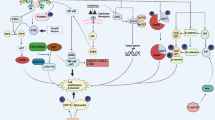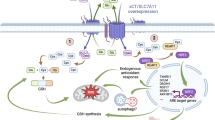Abstract
Insulin-like growth factor 1 (IGF-1) inhibits 5-fluorouracil (5-Fu)-induced apoptosis in esophageal carcinoma cells; however, the mechanisms for IGF-1-induced 5-Fu chemoresistance remain unknown. In the human esophageal carcinoma cell line, CE48T/VGH, we show that IGF-1 up-regulated survivin expression at the post-transcriptional level and this up-regulation is mediated by both the PI3-K/Akt and casein kinase 2 signaling pathways. We then examine whether IGF-1-induced 5-Fu chemoresistance is mediated through up-regulation of survivin. Ectopic expression of survivin inhibits 5-Fu-induced apoptosis; furthermore, the abolition of survivin expression sensitizes cells to 5-Fu treatment and prevents the anti-apoptotic function of IGF-1 in esophageal carcinoma cell lines. We also found that ectopic expression of survivin or treatment with IGF-1 inhibits the release of Smac/DIABLO and caspases activation after 5-Fu treatment. Our results strongly suggest that IGF-1 inhibits 5-Fu induced apoptosis through increasing survivin levels, which prevents Smac/DIABLO release and blocks the activation of caspases. Therefore, up-regulation of IGF-1 and survivin would seem to be responsible for 5-Fu chemoresistance in esophageal cancer patients and these factors may be the valuable predictors of 5-Fu chemoresistance in esophageal carcinoma.







Similar content being viewed by others
References
Enzinger PC, Ilson DH, Kelsen DP (1999) Chemotherapy in esophageal cancer. Semin Oncol 26:12–20
Sumpter K, Harper-Wynne C, Cunningham D et al (2005) Report of two protocol planned interim analyses in a randomised multicentre phase III study comparing capecitabine with fluorouracil and oxaliplatin with cisplatin in patients with advanced oesophagogastric cancer receiving ECF. Br J Cancer 92:1976–1983
Akutsu Y, Matsubara H, Shuto K et al (2009) Clinical and pathologic evaluation of the effectiveness of neoadjuvant chemoradiation therapy in advanced esophageal cancer patients. World J Surg 33:1002–1009
Longley DB, Harkin DP, Johnston PG (2003) 5-fluorouracil: mechanisms of action and clinical strategies. Nat Rev Cancer 3:330–338
Graidist P, Phongdara A, Fujise K (2004) Antiapoptotic protein partners fortilin and MCL1 independently protect cells from 5-fluorouracil-induced cytotoxicity. J Biol Chem 279:40868–40875
Zhu H, Guo W, Zhang L et al (2005) Bcl-XL small interfering RNA suppresses the proliferation of 5-fluorouracil-resistant human colon cancer cells. Mol Cancer Ther 4:451–456
Zhang S, Ding F, Luo A et al (2007) XIAP is highly expressed in esophageal cancer and its downregulation by RNAi sensitizes esophageal carcinoma cell lines to chemotherapeutics. Cancer Biol Ther 6:973–980
Ambrosini G, Adida C, Sirugo G, Altieri DC (1998) Induction of apoptosis and inhibition of cell proliferation by survivin gene targeting. J Biol Chem 273:11177–11182
Li F, Ambrosini G, Chu EY et al (1998) Control of apoptosis and mitotic spindle checkpoint by survivin. Nature 396:580–584
Altieri DC (2003) Survivin, versatile modulation of cell division and apoptosis in cancer. Oncogene 22:8581–8589
Rosato A, Pivetta M, Parenti A et al (2006) Survivin in esophageal cancer: an accurate prognostic marker for squamous cell carcinoma but not adenocarcinoma. Int J Cancer 119:1717–1722
Kato J, Kuwabara Y, Mitani M et al (2001) Expression of survivin in esophageal cancer: correlation with the prognosis and response to chemotherapy. Int J Cancer 95:92–95
Deveraux QL, Leo E, Stennicke HR, Welsh K, Salvesen GS, Reed JC (1999) Cleavage of human inhibitor of apoptosis protein XIAP results in fragments with distinct specificities for caspases. EMBO J 18:5242–5251
Marusawa H, Matsuzawa S, Welsh K et al (2003) HBXIP functions as a cofactor of survivin in apoptosis suppression. EMBO J 22:2729–2740
Dohi T, Okada K, Xia F et al (2004) An IAP-IAP complex inhibits apoptosis. J Biol Chem 279:34087–34090
Song Z, Yao X, Wu M (2003) Direct interaction between survivin and Smac/DIABLO is essential for the anti-apoptotic activity of survivin during taxol-induced apoptosis. J Biol Chem 278:23130–23140
Ceballos-Cancino G, Espinosa M, Maldonado V, Melendez-Zajgla J (2007) Regulation of mitochondrial Smac/DIABLO-selective release by survivin. Oncogene 26:7569–7575
Zhang M, Latham DE, Delaney MA, Chakravarti A (2005) Survivin mediates resistance to antiandrogen therapy in prostate cancer. Oncogene 24:2474–2482
Imsumran A, Adachi Y, Yamamoto H et al (2006) Insulin-like growth factor-I receptor as a marker for prognosis and a therapeutic target in human esophageal squamous cell carcinoma. Carcinogenesis 28:947–956
Liu YC, Leu CM, Wong FH et al (2002) Autocrine stimulation by insulin-like growth factor I is involved in the growth, tumorigenicity and chemoresistance of human esophageal carcinoma cells. J Biomed Sci 9:665–674
Cozza G, Mazzorana M, Papinutto E et al (2009) Quinalizarin as a potent, selective and cell-permeable inhibitor of protein kinase CK2. Biochem J 421:387–395
Sarno S, Reddy H, Meggio F et al (2001) Selectivity of 4, 5, 6, 7-tetrabromobenzotriazole, an ATP site-directed inhibitor of protein kinase CK2 (‘casein kinase-2’). FEBS Lett 496:44–48
Altieri DC (2008) Survivin, cancer networks and pathway-directed drug discovery. Nat Rev Cancer 8:61–70
Vaira V, Lee CW, Goel HL, Bosari S, Languino LR, Altieri DC (2006) Regulation of survivin expression by IGF-1/mTOR signaling. Oncogene 26:2678–2684
Tapia JC, Torres VA, Rodriguez DA, Leyton L, Quest AF (2006) Casein kinase 2 (CK2) increases survivin expression via enhanced {beta}-catenin-T cell factor/lymphoid enhancer binding factor-dependent transcription. Proc Natl Acad Sci USA 103:15079–15084
O’Connor DS, Grossman D, Plescia J et al (2000) Regulation of apoptosis at cell division by p34cdc2 phosphorylation of survivin. Proc Natl Acad Sci USA 97:13103–13107
Dohi T, Xia F, Altieri DC (2007) Compartmentalized phosphorylation of IAP by protein kinase A regulates cytoprotection. Mol Cell 27:17–28
Altieri DC, Marchisio PC (1999) Survivin apoptosis: an interloper between cell death and cell proliferation in cancer. Lab Invest 79:1327–1333
Kang BH, Altieri DC (2006) Regulation of survivin stability by the aryl hydrocarbon receptor-interacting protein (AIP). J Biol Chem 281:24721–24727
Fortugno P, Beltrami E, Plescia J et al (2003) Regulation of survivin function by Hsp90. Proc Natl Acad Sci USA 100:13791–13796
Ghosh JC, Dohi T, Kang BH, Altieri DC (2008) Hsp60 regulation of tumor cell apoptosis. J Biol Chem 283:5188–5194
Ling X, Bernacki RJ, Brattain MG, Li F (2004) Induction of survivin expression by taxol (paclitaxel) is an early event, which is independent of taxol-mediated G2/M arrest. J Biol Chem 279:15196–15203
Wall NR, O’Connor DS, Plescia J, Pommier Y, Altieri DC (2003) Suppression of survivin phosphorylation on Thr34 by flavopiridol enhances tumor cell apoptosis. Cancer Res 63:230–235
Brenes O, Arce F, Gatjens-Boniche O, Diaz C (2007) Characterization of cell death events induced by anti-neoplastic drugs cisplatin, paclitaxel and 5-fluorouracil on human hepatoma cell lines: possible mechanisms of cell resistance. Biomed Pharmacother 61:347–355
Iwasa T, Okamoto I, Suzuki M et al (2008) Radiosensitizing effect of YM155, a novel small-molecule survivin suppressant, in non-small cell lung cancer cell lines. Clin Cancer Res 14:6496–6504
Cohen BD, Baker DA, Soderstrom C et al (2005) Combination therapy enhances the inhibition of tumor growth with the fully human anti-type 1 insulin-like growth factor receptor monoclonal antibody CP-751, 871. Clin Cancer Res 11:2063–2073
Hu CP, Hsieh HG, Chien KY et al (1984) Biologic properties of three newly established human esophageal carcinoma cell lines. J Natl Cancer Inst 72:577–583
Wong FH, Hu CP, Chiu JH et al (1994) Expression of multiple oncogenes in human esophageal carcinomas. Cancer Invest 12:121–131
Waterhouse NJ, Goldstein JC, von AO, Schuler M, Newmeyer DD, Green DR (2001) Cytochrome c maintains mitochondrial transmembrane potential and ATP generation after outer mitochondrial membrane permeabilization during the apoptotic process. J Cell Biol 153:319–328
Ekert PG, Silke J, Hawkins CJ, Verhagen AM, Vaux DL (2001) DIABLO promotes apoptosis by removing MIHA/XIAP from processed caspase 9. J Cell Biol 152:483–490
Acknowledgments
This work was supported in part by grants from the National Science Council (NSC93-3112-B-010-026; NSC94-3112-B-010-012; NSC95-3112-B-010-003) and Ministry of Education, Aim for the Top University Plan (95A-C-T04-56; 96A-D-T137; 98A-C-D127) to F-H. Wong. We are grateful to Dr. Chen-Kung Chou (Graduate Institute of Basic Medical Science, Chang-Gung University, Taiwan) for helpful comments on the manuscript. We thank Dr. Michael Hsiao (Genomic Research Center of Academia Sinica, Taiwan) for the Ad-Akt-DN vector and the VGH National Yang-Ming University Genome Research Center (YMGC) for pOTB7-Smac plasmid.
Conflict of interest
The authors declare that they have no conflict of interest.
Author information
Authors and Affiliations
Corresponding author
Rights and permissions
About this article
Cite this article
Juan, HC., Tsai, HT., Chang, PH. et al. Insulin-like growth factor 1 mediates 5-fluorouracil chemoresistance in esophageal carcinoma cells through increasing survivin stability. Apoptosis 16, 174–183 (2011). https://doi.org/10.1007/s10495-010-0555-z
Published:
Issue Date:
DOI: https://doi.org/10.1007/s10495-010-0555-z




